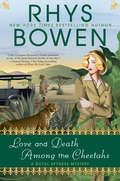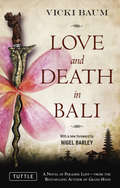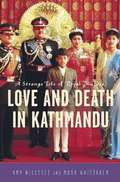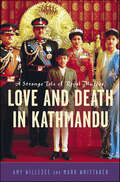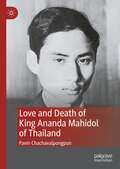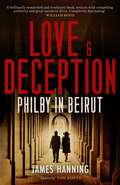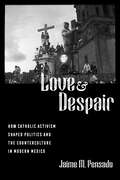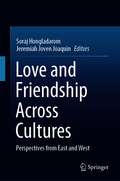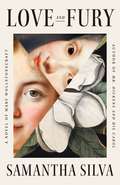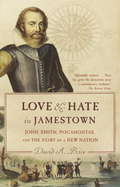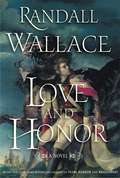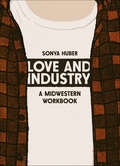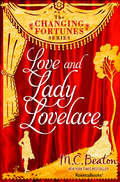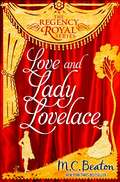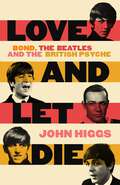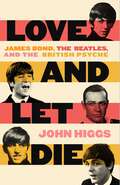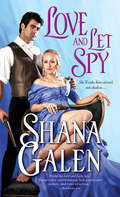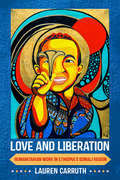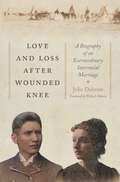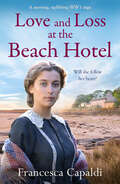- Table View
- List View
Love and Death Among the Cheetahs (A Royal Spyness Mystery #13)
by Rhys BowenGeorgie and Darcy are finally on their honeymoon in Kenya's Happy Valley, but murder crashes the party in this all-new installment in the New York Times bestselling series.I was so excited when Darcy announced out of the blue that we were flying to Kenya for our extended honeymoon. Now that we are here, I suspect he has actually been sent to fulfill another secret mission. I am trying very hard not to pick a fight about it, because after all, we are in paradise! Darcy finally confides that there have been robberies in London and Paris. It seems the thief was a member of the aristocracy and may have fled to Kenya. Since we are staying in the Happy Valley—the center of upper-class English life—we are well positioned to hunt for clues and ferret out possible suspects. Now that I am a sophisticated married woman, I am doing my best to sound like one. But crikey! These aristocrats are a thoroughly loathsome sort enjoying a completely decadent lifestyle filled with wild parties and rampant infidelity. And one of the leading lights in the community, Lord Cheriton, has the nerve to make a play for me. While I am on my honeymoon! Of course, I put an end to that right off. When he is found bloodied and lifeless along a lonely stretch of road, it appears he fell victim to a lion. But it seems that the Happy Valley community wants to close the case a bit too quickly. Darcy and I soon discover that there is much more than a simple robbery and an animal attack to contend with here in Kenya. Nearly everyone has a motive to want Lord Cheriton dead and some will go to great lengths to silence anyone who asks too many questions. The hunt is on! I just hope I can survive my honeymoon long enough to catch a killer. . . .
Love and Death in Bali
by Nigel Barley Vicki BaumSet against the backdrop of the Dutch invasion of Bali just over a century ago, and the resulting "mass suicides" of the Balinese royalty, Love and Death in Bali uses the tales of ordinary people to tell the bloody story of the conquest and subjugation of an island paradise.
Love and Death in Bali
by Nigel Barley Vicki BaumSet against the backdrop of the Dutch invasion of Bali just over a century ago, and the resulting "mass suicides" of the Balinese royalty, Love and Death in Bali uses the tales of ordinary people to tell the bloody story of the conquest and subjugation of an island paradise.
Love and Death in Bali
by Nigel Barley Vicki BaumSet against the backdrop of the Dutch invasion of Bali just over a century ago, and the resulting "mass suicides" of the Balinese royalty, the moving story unfolds of the peasant Pak and his family and friends, and the tragedy that is their shared fate.Written within living memory of the bloody events called the puputan (the "ending"), Love and Death in Bali is the story of a passionate yet peaceful and deeply spiritual people who defy the Dutch imperial forces through an act that would bring them certain death--and certain rebirth.The looting of a Chinese trading ship gives the Dutch colonial forces the perfect excuse to intervene in island affairs, but they encounter astonishing resistance. In the battle of Badung, wave upon wave of Balinese clothed in white ceremonial garb charged into the blazing Dutch guns, kris daggers in hand, prepared to die. Who among them will survive, and how will their lives be forever changed?Love and Death in Bali, first published in German in 1937, is considered by many to be the finest novel ever written about this island paradise where everyone, regardless of caste of position, is woven into the fabric of an ancient culture.
Love and Death in Kathmandu: A Strange Tale of Royal Murder
by Amy Willesee Mark WhittakerOn June 1, 2001, the heir to the Nepalese throne, Crown Prince Dipendra, donned military fatigues, armed himself with automatic weapons, walked in on a quiet family gathering, and, without a word, mowed his family down before turning a gun on himself. But Dipendra did not die immediately, and while lying in a coma was declared king. He was now a living god. Award-winning journalists Amy Willesee and Mark Whittaker set out to understand what could have led to such a devastating tragedy, one that fascinated and appalled the world. Exploring Kathmandu and other parts of the kingdom, they conducted exhaustive interviews with everyone from Maoist guerillas to members and friends of the royal family, gaining insight into the people involved in and the events behind the massacre. At the heart of the story is the love affair between Dipendra and the beautiful aristocrat Devyani Rana, whom he was forbidden to marry. Culminating their portrait of Nepal is a chilling reconstruction of the events of that fatal day. As conspiracy theories circulate and rebels threaten to topple the monarchy, the future of this small Himalayan kingdom, promises to be as tumultuous as its past. Revealing a country where the twenty-first century mingles uneasily with the fourteenth,Love and Death in Kathmandu is both an enlightening portrait of a place that is a world apart and a riveting investigation of an incredible crime.
Love and Death in Kathmandu: A Strange Tale of Royal Murder
by Amy Willesee Mark WhittakerOn June 1, 2001, the heir to the Nepalese throne, Crown Prince Dipendra, donned military fatigues, armed himself with automatic weapons, walked in on a quiet family gathering, and, without a word, mowed his family down before turning a gun on himself. But Dipendra did not die immediately, and while lying in a coma was declared king. He was now a living god. Award-winning journalists Amy Willesee and Mark Whittaker set out to understand what could have led to such a devastating tragedy, one that fascinated and appalled the world. Exploring Kathmandu and other parts of the kingdom, they conducted exhaustive interviews with everyone from Maoist guerillas to members and friends of the royal family, gaining insight into the people involved in and the events behind the massacre. At the heart of the story is the love affair between Dipendra and the beautiful aristocrat Devyani Rana, whom he was forbidden to marry. Culminating their portrait of Nepal is a chilling reconstruction of the events of that fatal day.As conspiracy theories circulate and rebels threaten to topple the monarchy, the future of this small Himalayan kingdom promises to be as tumultuous as its past. Revealing a country where the twenty-first century mingles uneasily with the fourteenth, Love and Death in Kathmandu is both an enlightening portrait of a place that is a world apart and a riveting investigation of an incredible crime.
Love and Death of King Ananda Mahidol of Thailand
by Pavin ChachavalpongpunThis book examines two aspects of the abbreviated reign of King Ananda Mahidol (1935-1946), or King Rama VIII, of the current Chakri dynasty of Thailand. First, it discusses the royal family’s plot to thwart a romantic relationship between the young king, Ananda, and his Swiss girlfriend, Marileine Ferrari, a daughter of a famous pastor of Lausanne, Switzerland. Interracial marriage, particularly with Westerners, has been strictly forbidden for Thai kings or heirs apparent. The restriction stems from the interwoven connection between sexual relationship and the security of the throne. The second part investigates the mysterious death of King Ananda, a long-held taboo topic in Thailand. Although the two events were not specially related, both in their own way served to unavoidably shake the position of the monarchy and hence threaten its existence. The palace’s reactions to these events demonstrated its continuous search to maintain its power and ultimately to warrant its survival.
Love and Deception: Philby in Beirut
by James Hanning'A brilliantly researched and revelatory book, written with compelling authority and great narrative drive. Completely fascinating' William BoydLove & Deception is the extraordinary story of how Eleanor, an able, cultured American living in the espionage hot spot of 1950s Beirut, fell in love with the kindest, most sensitive of men. Unknown to her, that man, a Lebanon-based journalist, Kim Philby, was under suspicion by the British and US intelligence services of having secretly signed up to help the Russians fight fascism in the 1930s, and of remaining in their pay at the height of the Cold War. Despite his mysterious past, Eleanor adored and married Philby, who later begged her to defy his difficulties. As the net closed in on Philby, he manoeuvred to save himself, but would their love survive?The outline of Philby's story is familiar to many, but Love & Deception breaks remarkable new ground - even for spy buffs. Through in-depth research, Hanning produces an eye-opening tale of friendship, politics, love, and loyalty.
Love and Deception: Philby in Beirut
by James Hanning'A brilliantly researched and revelatory book, written with compelling authority and great narrative drive. Completely fascinating' William BoydLove & Deception is the extraordinary story of how Eleanor, an able, cultured American living in the espionage hot spot of 1950s Beirut, fell in love with the kindest, most sensitive of men. Unknown to her, that man, a Lebanon-based journalist, Kim Philby, was under suspicion by the British and US intelligence services of having secretly signed up to help the Russians fight fascism in the 1930s, and of remaining in their pay at the height of the Cold War. Despite his mysterious past, Eleanor adored and married Philby, who later begged her to defy his difficulties. As the net closed in on Philby, he manoeuvred to save himself, but would their love survive?The outline of Philby's story is familiar to many, but Love & Deception breaks remarkable new ground - even for spy buffs. Through in-depth research, Hanning produces an eye-opening tale of friendship, politics, love, and loyalty.
Love and Despair: How Catholic Activism Shaped Politics and the Counterculture in Modern Mexico
by Jaime M. PensadoLove and Despair explores the multiple and mostly unknown ways progressive and conservative Catholic actors, such as priests, lay activists, journalists, intellectuals, and filmmakers, responded to the significant social and cultural shifts that formed competing notions of modernity in Cold War Mexico. Jaime M. Pensado demonstrates how the Catholic Church as a heterogeneous institution—with key transnational networks in Latin America and Western Europe—was invested in youth activism, state repression, and the counterculture from the postwar period to the more radical Sixties. Similar to their secular counterparts, progressive Catholics often saw themselves as revolutionary actors and nearly always framed their activism as an act of love. When their movements were repressed and their ideas were co-opted, marginalized, and commercialized at the end of the Sixties, the liberating hope of love often turned into a sense of despair.
Love and Friendship Across Cultures: Perspectives from East and West
by Soraj Hongladarom Jeremiah Joven JoaquinThis collection brings together different philosophical points of view discussing two important aspects of human life, namely love and friendship, within the broad context of comparative philosophy. These points of view differ in terms of their cultural orientations - East or West, ancient or modern; philosophical methodologies - analytical, historical, experimental, or phenomenological, broadly construed; and motivation - explanatory, revisionary, or argumentative. The volume is a comparative treatment of how diverse philosophical cultures view love and friendship, such as how Aristotle and Confucius’ views on friendship are similar and different, how the ancient Greeks and the Buddhists view friendship and happiness, and how posthumous love is possible. With contributions from a diverse set of scholars, this book presents the emerging views of Southeast Asian philosophers compared with those of philosophers from other regions, including Europe and North America. The volume thus provides a multi-faceted way of understanding love and friendship across cultures, and will be relevant to scholars interested in philosophy, the history of ideas, Asian Studies, and religious studies.
Love and Fury: A Novel of Mary Wollstonecraft
by Samantha SilvaA Best Novel of Summer (New York Times Book Review)From the acclaimed author of Mr. Dickens and His Carol, a richly-imagined reckoning with the life of another cherished literary legend: Mary Wollstonecraft – arguably the world’s first feministAugust, 1797. Midwife Parthenia Blenkinsop has delivered countless babies, but nothing prepares her for the experience that unfolds when she arrives at Mary Wollstonecraft’s door. Over the eleven harrowing days that follow, as Mrs. Blenkinsop fights for the survival of both mother and newborn, Wollstonecraft recounts the life she dared to live amidst the impossible constraints and prejudices of the late 18th century, rejecting the tyranny of men and marriage, risking everything to demand equality for herself and all women. She weaves her riveting tale to give her fragile daughter a reason to live, even as her own strength wanes. Wollstonecraft’s urgent story of loss and triumph forms the heartbreakingly brief intersection between the lives of a mother and daughter who will change the arc of history and thought.In radiant prose, Samantha Silva delivers an ode to the dazzling life of Mary Wollstonecraft, one of the world's most influential thinkers and mother of the famous novelist Mary Shelley. But at its heart, Love and Fury is a story about the power of a woman reclaiming her own narrative to pass on to her daughter, and all daughters, for generations to come.
Love and Glory
by Jeane Eddy WestinTHROUGH THE FIRE AND FURY OF WORLD WAR II, THEY RISKED THEIR HEARTS AND THEIR LIVES ... On a hot July day in 1942, at a military base in Iowa, their friendship began: wisecracking, softhearted Bunny; Page, the ambitious Army brat; naive, tormented Jill: elegant, sensual Elisabeth. Trading silk for khakis, they joined the U.S. Army as the first women officers-the WACs. From bomb-blasted England to Nazi France, from Italy to the Pacific, they plunged into the terror and splendor of war ... discovering the pride of command," the tragedy of sudden death, the passionate, deep loves that held a tender hope for tomorrow. Filled with all the ardor and gallantry of World War II. LOVE AND GLORY is the once-in-a-lifetime story of four American women who chose to serve their country-and change their destinies forever.
Love and Hate in Jamestown: John Smith, Pocahontas, and the Start of a New Nation
by David A. PriceA New York Times Notable Book and a San Jose Mercury News Top 20 Nonfiction Book of 2003. In 1606, approximately 105 British colonists sailed to America, seeking gold and a trade route to the Pacific. Instead, they found disease, hunger, and hostile natives. Ill prepared for such hardship, the men responded with incompetence and infighting; only the leadership of Captain John Smith averted doom for the first permanent English settlement in the New World.The Jamestown colony is one of the great survival stories of American history, and this book brings it fully to life for the first time. Drawing on extensive original documents, David A. Price paints intimate portraits of the major figures from the formidable monarch Chief Powhatan, to the resourceful but unpopular leader John Smith, to the spirited Pocahontas, who twice saved Smith's life. He also gives a rare balanced view of relations between the settlers and the natives and debunks popular myths about the colony. This is a superb work of history, reminding us of the horrors and heroism that marked the dawning of our nation.
Love and Honor
by Randall WallaceFrom the New York Times bestselling author of Pearl Harbor and Oscar-nominated writer of Braveheart comes an epic historical page-turner: the gripping, unforgettable story of a patriot's secret mission in Russia to save America from certain defeat on the eve of the Revolutionary War. A brilliant soldier and passionate patriot, Virginia cavalryman Kieran Selkirk is summoned to a clandestine meeting in the winter of 1774. There he finds none other than Benjamin Franklin, who reveals that the British have asked Catherine the Great, the ruthless and mysterious ruler of Russia, to provide twenty thousand of her soldiers to help stamp out the revolution brewing in America. Such a force, fresh from brutal warfare with the Turks, would crush all hope of American independence. Selkirk's assignment is straightforward -- and astounding. He is to travel to Russia disguised as a British mercenary, offer his services to the Tsarina in putting down a Cossack rebellion that threatens her throne, and convince her not to join the British in their war with America. To succeed, he must cross savage terrain, battle starving wolves, avoid secret assassins, fight marauding Cossacks, and contend with a court of seductive young women. In a narrative full of passion and peril, of battles on horseback and wars within the human soul, Selkirk's mission meets with thrilling surprises, including a romantic face-off with the legendary Catherine herself. Told with the hand of a master storyteller, Love and Honor is perhaps Wallace's most ambitious project yet, taking readers back to the eighteenth century in a patriotic novel brimming with romance and heroism on the grandest scale. Exotically transporting yet deeply American, Love and Honor captures the fight for good over evil, integrity and compassion over cruelty, and true love over all.
Love and Industry: A Midwestern Workbook
by Sonya Huber&“The 20 essays . . . pack a punch—not the sort that gives you an immediate bruise, but one that leaves you strangely sore for days . . .&” —Kerry Cardoza, Chicago Reader New Lenox, Illinois, is a small town deep in the corn grid of the Midwest, where it runs up against the grid of south Chicagoland, a placeless location marked by geographical flatness and dwindling industry. It&’s also where Sonya Huber grew up, and in the twenty essays collected here, she lovingly explores the ways New Lenox—and the Midwest more generally—has come to define her life. Here, you&’ll find portraits of Huber&’s parents as they tirelessly run a small business, homages to the Gen-X joys of wearing flannel, secret insights about being a Pizza Hut waitress, and odes to the ecstasy of blasting classic rock as your car hurls along I-80. Whether she&’s writing about All in the Family, detailing the region&’s influence on David Foster Wallace, or exploring the poetry embedded in a can of Miller High Life, her vision is astute and her prose convincing. Sometimes experimental and always inventive, Love and Industry: A Midwestern Workbook takes seriously Chicagoland&’s farthest reaches—gritty, sweeping, a region full of its own distinct feelings of &“almostness&”—and transforms them into a map of the heart, a ramshackle territory marked by memory, family, regret, determination, and wonderment. &“A must read&” —Library Journal &“Huber is a masterful essayist&” —Megan Stielstra, author of The Wrong Way to Save Your Life &“Sonya Huber has written a glorious midwestern road trip for the personal essay set.&” —Barrie Jean Borich, author of Apocalypse Darling, Body Geographic, and My Lesbian Husband
Love and Lady Lovelace (The Changing Fortunes Series #8)
by M. C. BeatonIt takes a gold-digger to know one in this Regency romance by the New York Times–bestselling author of the Hamish Macbeth mysteries.When young widow Lady Lovelace realizes she has been swindled to near-bankruptcy by her curmudgeonly cousin, she knows she will have to marry again for money. These are the very thoughts of Lord Philip, who has nothing between him and destitution but his small army pension. And so, these two attractive fortune-hunters somehow find each other and before long, pop into marriage—and into the bridal chamber—only to discover they were both virtually penniless. What a diabolical situation. What would they do now?ABOUT THE COLLECTION What could be more engaging than the women who rise from the commoner classes and minor nobility to triumph in the unforgiving high society of London. Read about women who have lost their fortunes, country girls at their first season, and new wives who can&’t resist temptation in the nine titles of the Changing Fortunes Collection.
Love and Lady Lovelace: Regency Royal 10 (Regency Royal #8)
by M.C. BeatonWhen young widow Lady Lovelace realized she had been swindled to near-bankruptcy by her curmudgeonly cousin, she knew she would have to marry again for money.These were the very thoughts of Lord Philip, who had nothing between him and destitution but his small army pension. And so these two attractive fortune-hunters somehow found each other and before long, popped into marriage - and into the bridal chamber - only to discover they were both virtually penniless.What a diabolical situation. What would they do now?
Love and Let Die: Bond, the Beatles and the British Psyche
by John HiggsThe Beatles are the biggest band there has ever been. James Bond is the single most successful movie character of all time. They are also twins. Dr No, the first Bond film, and 'Love Me Do', the first Beatles record, were both released on the same day - Friday, 5 October 1962. Most countries can only dream of a cultural export becoming a worldwide phenomenon on this scale. For Britain to produce two on the same windy October afternoon is unprecedented.Bond and the Beatles present us with opposing values, visions of Britain and ideas about male identity. LOVE AND LET DIE is the story of a clash between working-class liberation and establishment control, and how it exploded on the global stage. It explains why James Bond hated the Beatles, why Paul McCartney wanted to be Bond and why it was Ringo who won the heart of a Bond Girl in the end.Told over a period of sixty dramatic years, this is an account of how two outsized cultural monsters continue to define our aspirations and fantasies and the future we are building. Looking at these touchstones in this new context will forever change how you see the Beatles, the James Bond films and six decades of British culture.
Love and Let Die: James Bond, The Beatles, and the British Psyche
by John HiggsA deep-dive into the unique connections between the two titans of the British cultural psyche—the Beatles and the Bond films—and what they tell us about class, sexuality, and our aspirations over sixty dramatic years.The Beatles are the biggest band in the history of pop music. James Bond is the single most successful movie character of all time. They are also twins. Dr No, the first Bond film, and Love Me Do, the first Beatles record, were both released on the same day: Friday 5 October 1962. Most countries can only dream of a cultural export becoming a worldwide phenomenon on this scale. For Britain to produce two iconic successes on this level, on the same windy October afternoon, is unprecedented. Bond and the Beatles present us with opposing values, visions of the British culture, and ideas about sexual identity. Love and Let Die is the story of a clash between working class liberation and establishment control, and how it exploded on the global stage. It explains why James Bond hated the Beatles, why Paul McCartney wanted to be Bond, and why it was Ringo who won the heart of a Bond Girl in the end. Told over a period of sixty dramatic years, this is an account of how two outsized cultural phenomena continue to define American aspirations, fantasies, and our ideas about ourselves. Looking at these two touchstones in this new context will forever change how you see the Beatles, the James Bond films, and six decades of cross-Atlantic popular culture.
Love and Let Spy
by Shana GalenHer name is Bonde, Jane Bonde... A beautiful and eligible member of the ton, Jane has more than a few secrets: she's one of the Crown's most elite agents. She may be deadly, but she doesn't know a thing about fashion, flirtation, or love...until Dominic Griffyn shakes up her carefully stirred world and asks her to be his bride. He's exactly the kind of man she's not looking for. And he's dangerous, because falling into his arms is so much more satisfying than saving England from her enemies. He's an improper gentleman who needs a wife... Tall, dark, and tortured, Dominic Griffyn is haunted by demons from his past. When his stepfather insists that he marry, Dominic allows himself to hope that the beautiful but mysterious Miss Bonde might help him forget his troubles. As they grow closer, it's clear that there's more to Jane than danger. She might be just what his neglected heart needs.
Love and Liberation: Autobiographical Writings of the Tibetan Buddhist Visionary Sera Khandro
by Sarah JacobyLove and Liberation reads the autobiographical and biographical writings of one of the few Tibetan Buddhist women to record the story of her life. Sera Khandro Künzang Dekyong Chönyi Wangmo (also called Dewé Dorjé, 1892–1940) was extraordinary not only for achieving religious mastery as a Tibetan Buddhist visionary and guru to many lamas, monastics, and laity in the Golok region of eastern Tibet, but also for her candor. This book listens to Sera Khandro's conversations with land deities, dakinis, bodhisattvas, lamas, and fellow religious community members whose voices interweave with her own to narrate what is a story of both love between Sera Khandro and her guru, Drimé Özer, and spiritual liberation. Sarah H. Jacoby's analysis focuses on the status of the female body in Sera Khandro's texts, the virtue of celibacy versus the expediency of sexuality for religious purposes, and the difference between profane lust and sacred love between male and female tantric partners. Her findings add new dimensions to our understanding of Tibetan Buddhist consort practices, complicating standard scriptural presentations of male subject and female aide. Sera Khandro depicts herself and Drimé Özer as inseparable embodiments of insight and method that together form the Vajrayana Buddhist vision of complete buddhahood. By advancing this complementary sacred partnership, Sera Khandro carved a place for herself as a female virtuoso in the male-dominated sphere of early twentieth-century Tibetan religion.
Love and Liberation: Humanitarian Work in Ethiopia's Somali Region
by Lauren CarruthLauren Carruth's Love and Liberation tells a new kind of humanitarian story. The protagonists are not volunteers from afar but rather Somali locals caring for each other: nurses, aid workers, policymakers, drivers, community health workers, and bureaucrats. The contributions of locals are often taken for granted, and the competencies, aspirations, and effectiveness of local staffers frequently remain muted or absent from the planning and evaluation of humanitarian interventions structured by outsiders. Relief work is traditionally imagined as politically neutral and impartial, and interventions are planned as temporary, extraordinary, and distant. Carruth provides an alternative vision of what "humanitarian" response means in practice—not driven by International Humanitarian Law, the missions of Western relief organizations, or trends in the aid industry or academia but instead by what Somalis call samafal. Samafal is structured by the cultivation of lasting relationships of care, interdependence, kinship, and ethnic solidarity. Samafal is also explicitly political and potentially emancipatory: humanitarian responses present opportunities for Somalis to begin to redress histories of colonial partitions and to make the most out of their political and economic marginalization. By centering Love and Liberation around Somalis' understanding and enactments of samafal, Carruth offers a new perspective on politics and intervention in Africa.
Love and Loss After Wounded Knee: A Biography of an Extraordinary Interracial Marriage
by Julie DobrowA dual biography of two activists whose marriage challenged the gender and racial norms of their timeLike any set of star-crossed lovers, Elaine and Charles came from different worlds. Elaine, an acclaimed childhood poet from a remote corner of the Massachusetts Berkshires, traveled to the Dakota Territories to teach Native American students, undaunted by society’s admonitions. Charles, a Dakota Sioux from Minnesota, educated at Dartmouth and Boston University Medical School, was considered by his Euro-American mentors the epitome of an assimilated Indian. But when they met just ahead of the Wounded Knee Massacre in 1890, the magnetic pull of love brought them together despite the tremendous odds stacked against them. Love and Loss After Wounded Knee offers a dual biography of Elaine Goodale and Ohíye’Sa, (Dr. Charles Alexander Eastman), exploring their individual lives as well as their highly publicized interracial marriage. Both well-known in their own time– Elaine as a poet, journalist, and advocate for Indian education and Charles as writer, public speaker, and ardent activist for Indian rights– their marriage started with a shared vision to work on behalf of Indians. In the face of extreme prejudice, financial burden, and personal tragedy however, the marriage began to unravel. Dobrow paints an intimate, emotional portrait of the Eastmans’ lives drawn from Elaine and Charles’s letters, papers, and hundreds of accounts of the Eastmans’ lives from newspapers. Along the way, she skillfully illuminates the shifting late 19th and early 20th century definitions of Indigenous identity, and reveals how the Eastmans’ legacies reflect changing American attitudes toward gender, interracial relationships and biracial children. The result is a compelling new history that weds the private and the political, and Native America and the United States of America– entwined yet separated, inextricable yet never fully joined, just like Elaine and Charles themselves.
Love and Loss at the Beach Hotel: A moving, uplifting WW1 saga (Beach Hotel Series)
by Francesca CapaldiCan true love win the day? Hetty Affleck is working as a maid at the prestigious Beach Hotel in Littlehampton. Her beau, Lorcan, is away at war and has recently stopped replying to her letters but she is determined to keep her spirits up. When she meets wealthy shipbuilder’s son Victor Perryman, they pass the time of day and they both feel a connection but she can’t allow herself to think anything more of it - not only does she have Lorcan to think of, but she and Victor are divided by wealth and class. Yet they meet again and Hetty is charmed and intrigued by Victor and his openness towards her. It becomes harder to ignore the attachment growing between them. When Lorcan comes back on leave, Hetty is forced to face her true feelings. Who does she really love, and can that love conquer everything in its path? An uplifting, emotional WW1 saga perfect for fans of Ginny Bell and Jean Fullerton Readers adore the Beach Hotel series: ‘Oh wow this story was…amazing and heartfelt…I hope there will be more in this series’***** Reader Review ‘Had me turning the pages well into the night… A five-star, well-written beach caper. A page turner from beginning to end.’***** Reader Review ‘I have enjoyed all three books in this series but this one was the best! I think that is because it is Helen’s story and Helen is the very heart of the hotel…I really enjoyed it.’***** Reader Review ‘The strong thread that runs through this series is friendship, that’s exactly what Helen Bygrove needs when things get difficult! I know it was third in series but I’m sure there’s room for a follow up! I live in hope.’***** Reader Review ‘Another brilliant book by this brilliant author’ Reader Review ‘Brilliant storyline, brilliant book. Couldn’t put it down. Family saga at its best’***** Reader Review ‘I loved this enchanting read…could not put it down…’***** Reader Review ‘Well, what a start to a new series! There are many secrets to be uncovered…I loved this book.’***** Reader Review ‘Charming…this book felt like an escape…The story was heartwarming’***** Reader Review ‘I thoroughly enjoyed this book…I’m glad there is more to come from the Beach Hotel.’***** Reader Review
